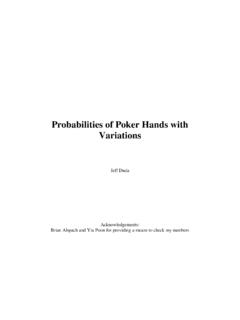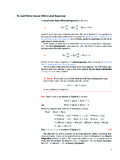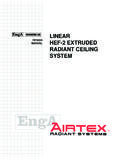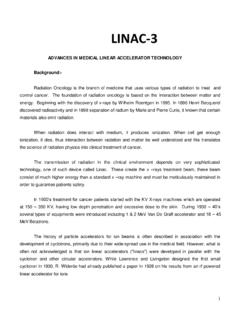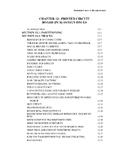Transcription of Quasi-Linear Convective System Mesovorticies and …
1 Quasi-Linear Convective System Mesovorticies and Tornadoes RYAN ALLISS & MATT HOFFMAN Meteorology Program, Iowa State University, Ames ABSTRACT Quasi-Linear Convective System are a common occurance in the spring and summer months and with them come the risk of them producing Mesovorticies . These Mesovorticies are small and compact and can cause isolated and concentrated areas of damage from high winds and in some cases can produce weak tornadoes. This paper analyzes how and when QLCSs and Mesovorticies develop, how to identify a mesovortex using various tools from radar, and finally a look at how common is it for a QLCS to put spawn a tornado across the United Introduction Supercells have always been most feared when it has come to tornadoes and as they should be.
2 However, Quasi-Linear Convective systems can also cause tornadoes. Squall lines and bow echoes are also known to cause tornadoes as well as other forms of severe weather such as high winds, hail, and microbursts. These are powerful systems that can travel for hours and hundreds of miles, but the worst part is tornadoes in QLCSs are hard to forecast and can be highly dangerous for the public. Often times the supercells within the QLCS cause tornadoes to become rain wrapped, which are tornadoes that are surrounded by rain making them hard to see with the naked eye. This is why understanding QLCSs and how they can produce mesovortices that are capable of producing tornadoes is essential to forecasting these tornadic events that can be highly dangerous. 2. Quasi-Linear Convective Systems a.
3 General Background Quasi-Linear Convective systems, or squall lines, are a line of thunderstorms that are oriented linearly. Sometimes, these lines of intense thunderstorms can feature a bowed out Figure 1: Quasi-Linear Convective System with a very indentifiable bow echoe. center that races ahead of the main line. This is known as a bow echoe. Bow echoes are formed due to a strong rush of flow into the backside of the squall line, which will give the squall line a bowed shape making it a bow echo. The time series of a bow echoe can be seen in figure 2. These storms often can produce damaging hail as well as severe straight line winds. Along with the risk of hail and straight line winds, there is also the risk of tornadoes with both squall lines and bow echoes. They occur primarily in the spring and especially summer months.
4 An example of a typical QLCS and bow echo on radar reflectivity can be seen in figure 1. b. Atmospheric Process The development of the QLCS is dependent on the storm produced cold pool and the environmental shear. Once these two components can find a balance then the QLCS becomes a machine that can go great distances, producing severe weather including even tornadoes. Both the motion of the cold pool and the environmental shear cause horizontal vorticity, which can help in the production of tornadoes associated with QLCSs. The main contributer is their interactions may cause a powerful updraft as the cold pool advances. The cold pool has colder, denser rain cooled air and cuts into the warm air out ahead that is spinning horizontally due to the shear. This causes the air just ahead of the cold pool to be forced upward producing convection and sustaining the storm System .
5 This process is most efficient when the horizontal voritcity of the cold pool versus the enivornmental shear is the same because it leads to the strongest updrafts to power the storm (Louisville NWS). Once a QLCS develops it can become a bow echoe if a portion of the storm accelerates ahead causing a bowed appearance on radar reflectivity. That signature represents very strong winds that often cause straight line winds from the rear inflow jet. The rear inflow jet is a feature that can separate a damaging mesovortex that can produce a tornado from non-threatening mesovortices. c. QLCS Forecasting 1) SUMMER These QLCSs usually occur during the summer months along a generally east to west oriented frontal boundary with very strong convergence and substantial dew points along the front with the highest values being just to the south of the front, which is commonly a warm or stationary front.
6 The QLCSs will normally follow a path that is parallel to the front with a gradual and slight component into the warm sector of the boundary (Louisville NWS). In the upper levels, development is enhanced by straight or anticyclonically curved mid or upperlevel flow near the axis of the ridge was as well as a weak shortwave trough near the region where the QLCS develops. Strong warm air advection at 850mb and 700mb are also helpful in the area where a QLCS may develop. Very high moisture at 850mb is accumulated to the south of the eventual track of the bow echo with drier air at 700mb, which helps with enhancing damaging straight line wind potential (Louisville NWS). QLCS development also depends on unstable airmasses with Convective available potential energy (CAPE) values in the area of Figure 2: Typical lifecycle of a bow echo from formation on average of 2400 J/kg.
7 Wind shear is a large component of QLCS development with moderate to strong speed shear parallel to the storm track as well some directional shear with veering of the 850 mb and 700mb winds (Louisville NWS). 2) SPRING In the spring time the conditions that favor QLCS development change somewhat. At the surface, development is dependent on strong low pressure systems and form in the warm sector ahead of the cold front or along or just to the north of the warm front. At upper levels winds are much more potent than in the summer case with moderate or strong winds throughout the atmosphere with even 30-60 kts at 850mb. There is also significant diveregence and convergence fields that lead to strong lift to overcome a lack of moisture or instability. CAPE values are between 500-2000 J/kg and there is usually a layer of dry or even cool air in mid-levels that can be entrained into the squall line to increase damaging wind potential.
8 Directional shear isn t as prevelant in the spring cases, but speed shear is very strong with shear for bow echoes being 50 kts within the lowest of the atmosphere and minimal shear aloft. 3. Mesovortices Along the bowed out segements of the QLCS, mesovortices often form on the northern side of the bow and usually rotate cyclonically. Mesovorticies are compact couplets of quickly spinning air with very high vertical vorticity. It does appear that Mesovorticies and their wind potential can cause more concentrated and intense damage than the straight line winds at the apex of the bow due to the rear inflow jet. These Mesovorticies do produce strong winds, but can also produce brief tornadoes that are commonly fairly weak with respect to the damaging straight line winds Mesovorticies can cause (Weisman & Trapp, 2003).
9 Mesovorticies differ from mesocyclones in that they are low level storm features within 1 km from the surface. Meanwhile, mesocylones are more common at mid levels, but sometimes they can occur at low levels. Because of this, Mesovorticies tend to build upwards while mesocyclones build downward. Mesocyclones are more associated with isolated supercell thunderstorms while Mesovorticies are associated with squall lines and bow echoes. Their placement in relation to the storm is also different with Mesovorticies forming along the leading edge of the QLCS near the downdraft region. Mesocyclones form on the backside of the storm in the updraft region (Weisman & Trapp, 2003). 4. Mesovortex genesis Three main likely contributors have been investigated pertaining to mesovortex generation. These include cyclonic-anticyclonic couplets formed in a late Convective cell and as a Quasi-Linear Convective System is beginning to organize, cyclonic-only vorticies that tend to form during the mature stage of a bow echo, and a possible mechanism from shearing instability.
10 Each process will now be reviewed in detail. a. Cyclonic-anticyclonic couplets As the gust front from the QLCS begins to propagate ahead of the main System ,bulges in the gust front have been observed. This bulge produces cyclonic rotation to the north and anti-cyclonic rotation to the south with a vertical orientation. First, some local maxima in the Convective downdraft is produced forcing the air in that region to move quicker and out ahead of the neighboring parcels. This creates the bulge along the main outflow. Meanwhile because of baroclinicity across the gust front itself horizontal vorticity is produced from the solenoidal term in the horizontal vorticity equation. Some form of tilting is introduced, either by the updraft or the downdraft. Trapp and Weisman found in their idealized simulation in 2003 that the tilting was due to the updraft. Once some component of the vortex lines have been tilted into the vertical a smaller scale updraft maxima stretches the column, intensifies the vertical vorticty and creates the mesovorticie.
